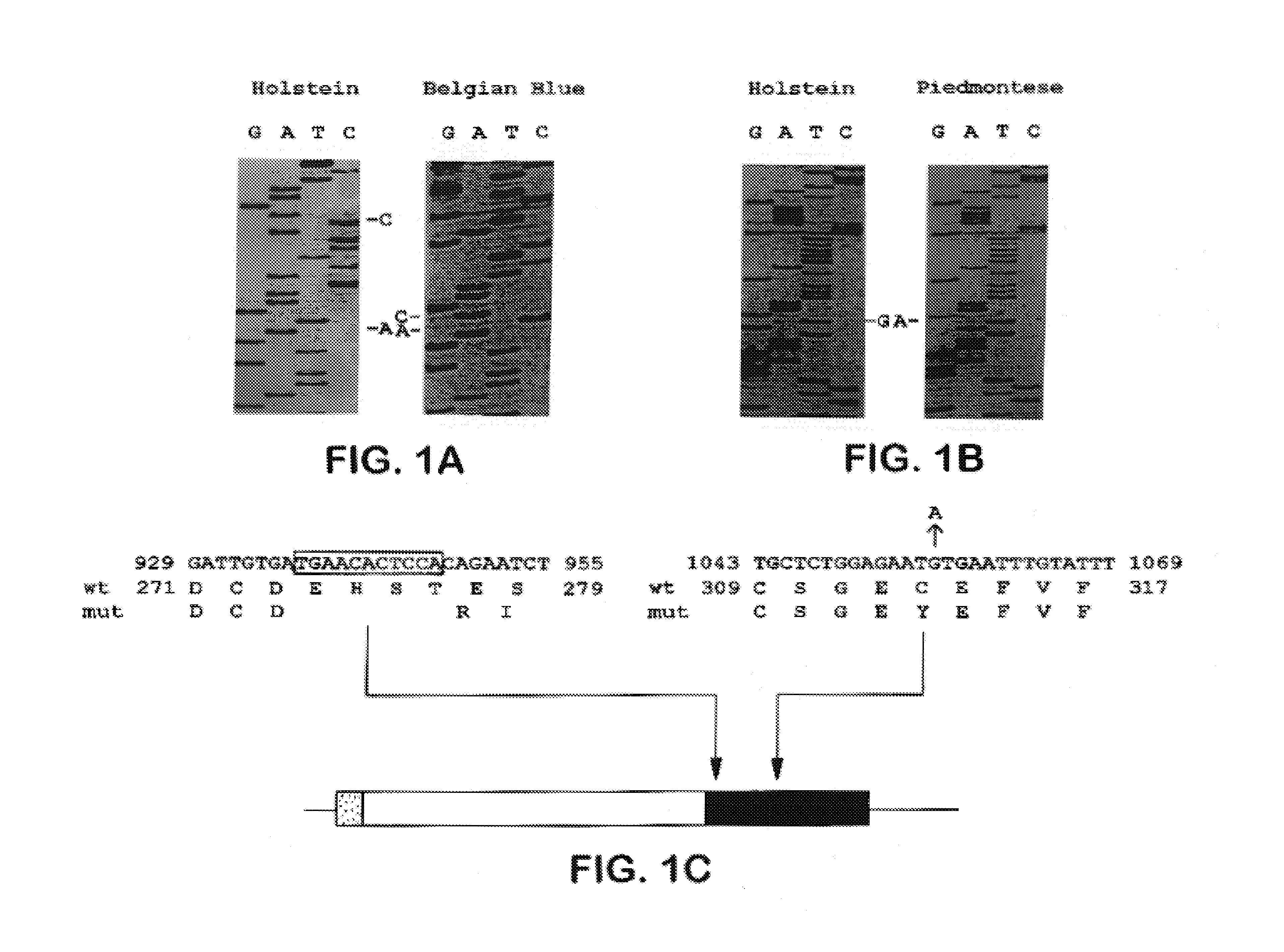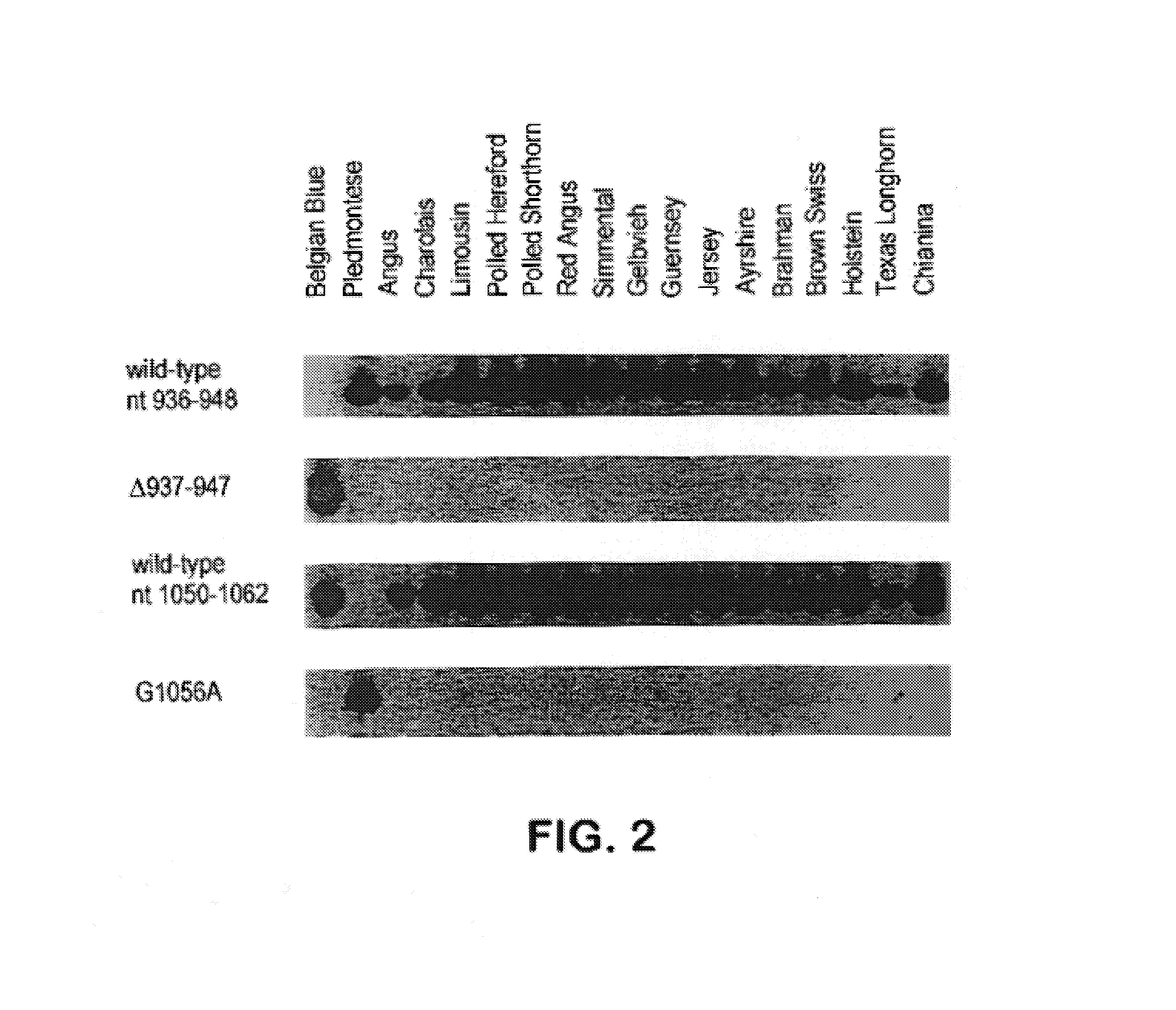Methods for detection of mutations in myostatin variants
a technology of myostatin and variants, applied in the field of growth factors, can solve the problems of limited success in the preparation of animal foodstuffs
- Summary
- Abstract
- Description
- Claims
- Application Information
AI Technical Summary
Benefits of technology
Problems solved by technology
Method used
Image
Examples
example 1
[0109]Poly A-containing RNA was isolated from human (obtained from the International Institute for the Advancement of Medicine, Exton, Pa.), Holstein cow, sheep (Ruppersberger & Sons, Baltimore, Md.), pig (Bullock's Country Meats, Westminster, Md.), White Leghorn chicken (Truslow Farms, Chestertown, Md.), turkey (kindly provided by D. Boyer and D. Miller at Wampler Foods, Oxford, Pa.) and zebrafish (kindly provided by S. Fisher and M. Halpern) skeletal muscle tissue as described previously (Lee, S-J., Mol. Endocrinol. 4: 1034). cDNA libraries were constructed in the lambda ZAP II vector (Stratagene, La Jolla, Calif.) according to the instructions provided by the manufacturer and screened without amplification. Rat and baboon skeletal muscle cDNA libraries and a bovine (Holstein) genomic library were purchased from Stratagene. Library screening and analysis of clones were carried out as described (5) except that the final washes were carried out in 25 mM sodium ph...
example 2
Sequencing of Bovine Genomic DNA
[0110]Blood from cattle was spun at 5,000 rpm for 15 min., resuspended in 150 mM NaCl, 100 mM EDTA, and digested with 200 μg ml−1 proteinase K, 1% SDS at 44° C. Semen (Select Sires, Rocky Mount, Va.) was digested in 50 mM Tris pH 8.0, 20 mM EDTA, 1% sarcosyl, 0.2 M β-mercaptoethanol, 200 μg ml−1 proteinase K. DNAs were purified on a CsCl gradient. Exon 3 was amplified by PCR from 1 μg genomic DNA using primer pairs 137ACM 5′-CGCGGATCCGAGGTAGGAGAGTGTTTTGGGATC-3′ (SEQ ID NO:3) and 138ACM 5′-CGCGGATCCCACAGTTTCAAAATTGTTGAGGGG-3′ (SEQ ID NO:4) at 94° C. for 1 min., 52° C. for 2 min. and 72° C. for 2 min. for 40 cycles. PCR products were digested with BamHI, subcloned into pBluescript and sequenced.
example 3
Southern Blot Analysis of Myostatin Variants
[0111]One-fifth of exon 3 amplification products were electrophoresed on 2% agarose gels, blotted to nylon membranes, hybridized with 32P-labeled 13-mers as described (Gärtner et al., Nature Genetics 1:16, 1992) and washed in 30 mM sodium citrate, 300 mM NaCl, 0.1% SDS. Primers used were 146 ACM 5′-ATGAACACTCCAC-3′ (SEQ ID NO:9) (Holstein wild-type sequence, nucleotides 936-948), 145ACM 5′-TTGTGACAGAATC-3′ (SEQ ID NO:10) (Belgian Blue mutation, nucleotides 931-936 with 948-954), 673SJL 5′-GAGAATGTGAATT-3′ (SEQ ID NO: 11) (Holstein wild-type sequence, nucleotides 1050-1062) and 674SJL 5′-GAGAATATGAATT-3′ (SEQ ID NO: 12) (Piedmontese mutation, G1056A).
PUM
| Property | Measurement | Unit |
|---|---|---|
| temperatures | aaaaa | aaaaa |
| temperature | aaaaa | aaaaa |
| temperature | aaaaa | aaaaa |
Abstract
Description
Claims
Application Information
 Login to View More
Login to View More - R&D
- Intellectual Property
- Life Sciences
- Materials
- Tech Scout
- Unparalleled Data Quality
- Higher Quality Content
- 60% Fewer Hallucinations
Browse by: Latest US Patents, China's latest patents, Technical Efficacy Thesaurus, Application Domain, Technology Topic, Popular Technical Reports.
© 2025 PatSnap. All rights reserved.Legal|Privacy policy|Modern Slavery Act Transparency Statement|Sitemap|About US| Contact US: help@patsnap.com


